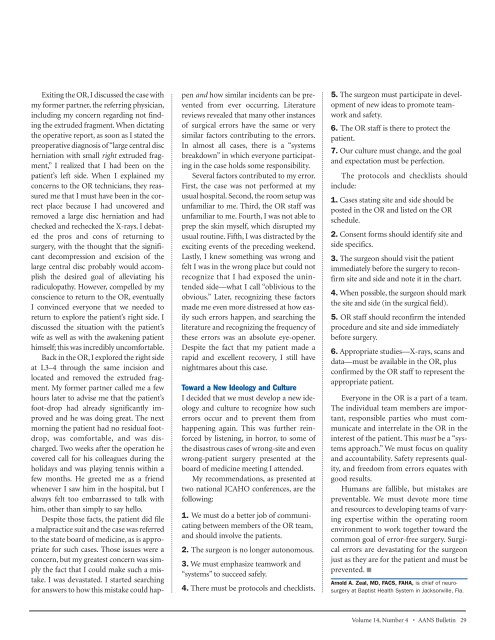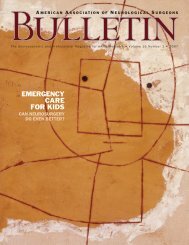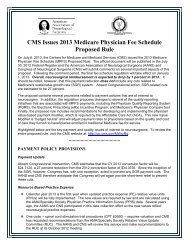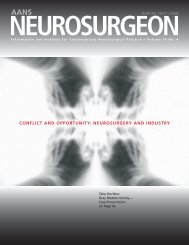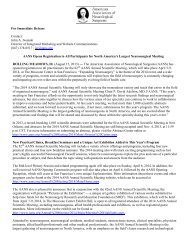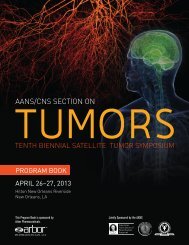view PDF - American Association of Neurological Surgeons
view PDF - American Association of Neurological Surgeons
view PDF - American Association of Neurological Surgeons
You also want an ePaper? Increase the reach of your titles
YUMPU automatically turns print PDFs into web optimized ePapers that Google loves.
Exiting the OR, I discussed the case with<br />
my former partner, the referring physician,<br />
including my concern regarding not finding<br />
the extruded fragment. When dictating<br />
the operative report, as soon as I stated the<br />
preoperative diagnosis <strong>of</strong> “large central disc<br />
herniation with small right extruded fragment,”<br />
I realized that I had been on the<br />
patient’s left side. When I explained my<br />
concerns to the OR technicians, they reassured<br />
me that I must have been in the correct<br />
place because I had uncovered and<br />
removed a large disc herniation and had<br />
checked and rechecked the X-rays. I debated<br />
the pros and cons <strong>of</strong> returning to<br />
surgery, with the thought that the significant<br />
decompression and excision <strong>of</strong> the<br />
large central disc probably would accomplish<br />
the desired goal <strong>of</strong> alleviating his<br />
radiculopathy. However, compelled by my<br />
conscience to return to the OR, eventually<br />
I convinced everyone that we needed to<br />
return to explore the patient’s right side. I<br />
discussed the situation with the patient’s<br />
wife as well as with the awakening patient<br />
himself; this was incredibly uncomfortable.<br />
Back in the OR, I explored the right side<br />
at L3–4 through the same incision and<br />
located and removed the extruded fragment.<br />
My former partner called me a few<br />
hours later to advise me that the patient’s<br />
foot-drop had already significantly improved<br />
and he was doing great. The next<br />
morning the patient had no residual footdrop,<br />
was comfortable, and was discharged.<br />
Two weeks after the operation he<br />
covered call for his colleagues during the<br />
holidays and was playing tennis within a<br />
few months. He greeted me as a friend<br />
whenever I saw him in the hospital, but I<br />
always felt too embarrassed to talk with<br />
him, other than simply to say hello.<br />
Despite those facts, the patient did file<br />
a malpractice suit and the case was referred<br />
to the state board <strong>of</strong> medicine, as is appropriate<br />
for such cases. Those issues were a<br />
concern, but my greatest concern was simply<br />
the fact that I could make such a mistake.<br />
I was devastated. I started searching<br />
for answers to how this mistake could happen<br />
and how similar incidents can be prevented<br />
from ever occurring. Literature<br />
re<strong>view</strong>s revealed that many other instances<br />
<strong>of</strong> surgical errors have the same or very<br />
similar factors contributing to the errors.<br />
In almost all cases, there is a “systems<br />
breakdown” in which everyone participating<br />
in the case holds some responsibility.<br />
Several factors contributed to my error.<br />
First, the case was not performed at my<br />
usual hospital. Second, the room setup was<br />
unfamiliar to me. Third, the OR staff was<br />
unfamiliar to me. Fourth, I was not able to<br />
prep the skin myself, which disrupted my<br />
usual routine. Fifth, I was distracted by the<br />
exciting events <strong>of</strong> the preceding weekend.<br />
Lastly, I knew something was wrong and<br />
felt I was in the wrong place but could not<br />
recognize that I had exposed the unintended<br />
side—what I call “oblivious to the<br />
obvious.” Later, recognizing these factors<br />
made me even more distressed at how easily<br />
such errors happen, and searching the<br />
literature and recognizing the frequency <strong>of</strong><br />
these errors was an absolute eye-opener.<br />
Despite the fact that my patient made a<br />
rapid and excellent recovery, I still have<br />
nightmares about this case.<br />
Toward a New Ideology and Culture<br />
I decided that we must develop a new ideology<br />
and culture to recognize how such<br />
errors occur and to prevent them from<br />
happening again. This was further reinforced<br />
by listening, in horror, to some <strong>of</strong><br />
the disastrous cases <strong>of</strong> wrong-site and even<br />
wrong-patient surgery presented at the<br />
board <strong>of</strong> medicine meeting I attended.<br />
My recommendations, as presented at<br />
two national JCAHO conferences, are the<br />
following:<br />
1. We must do a better job <strong>of</strong> communicating<br />
between members <strong>of</strong> the OR team,<br />
and should involve the patients.<br />
2. The surgeon is no longer autonomous.<br />
3. We must emphasize teamwork and<br />
“systems” to succeed safely.<br />
4. There must be protocols and checklists.<br />
5. The surgeon must participate in development<br />
<strong>of</strong> new ideas to promote teamwork<br />
and safety.<br />
6. The OR staff is there to protect the<br />
patient.<br />
7. Our culture must change, and the goal<br />
and expectation must be perfection.<br />
The protocols and checklists should<br />
include:<br />
1. Cases stating site and side should be<br />
posted in the OR and listed on the OR<br />
schedule.<br />
2. Consent forms should identify site and<br />
side specifics.<br />
3. The surgeon should visit the patient<br />
immediately before the surgery to reconfirm<br />
site and side and note it in the chart.<br />
4. When possible, the surgeon should mark<br />
the site and side (in the surgical field).<br />
5. OR staff should reconfirm the intended<br />
procedure and site and side immediately<br />
before surgery.<br />
6. Appropriate studies—X-rays, scans and<br />
data—must be available in the OR, plus<br />
confirmed by the OR staff to represent the<br />
appropriate patient.<br />
Everyone in the OR is a part <strong>of</strong> a team.<br />
The individual team members are important,<br />
responsible parties who must communicate<br />
and interrelate in the OR in the<br />
interest <strong>of</strong> the patient. This must be a “systems<br />
approach.” We must focus on quality<br />
and accountability. Safety represents quality,<br />
and freedom from errors equates with<br />
good results.<br />
Humans are fallible, but mistakes are<br />
preventable. We must devote more time<br />
and resources to developing teams <strong>of</strong> varying<br />
expertise within the operating room<br />
environment to work together toward the<br />
common goal <strong>of</strong> error-free surgery. Surgical<br />
errors are devastating for the surgeon<br />
just as they are for the patient and must be<br />
prevented. 3<br />
Arnold A. Zeal, MD, FACS, FAHA, is chief <strong>of</strong> neurosurgery<br />
at Baptist Health System in Jacksonville, Fla.<br />
Volume 14, Number 4 • AANS Bulletin 29


